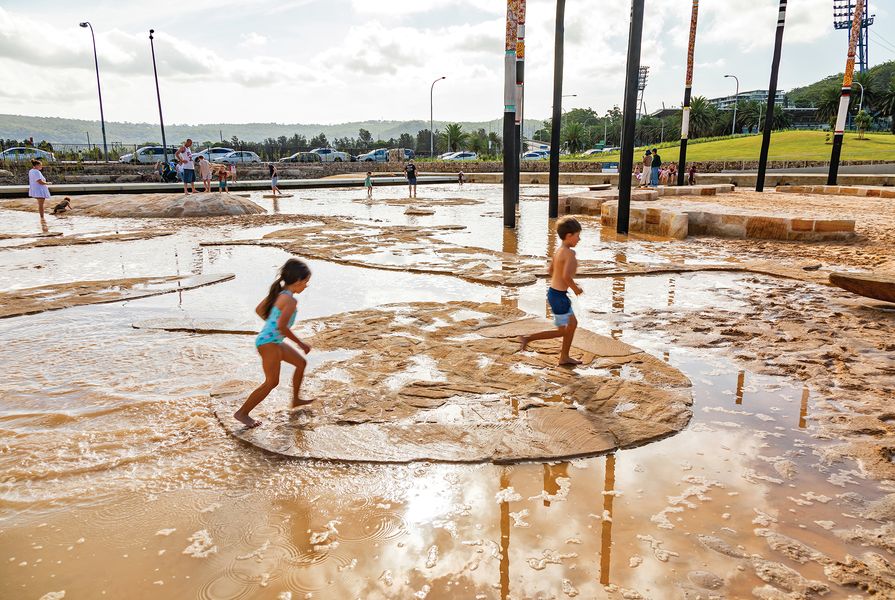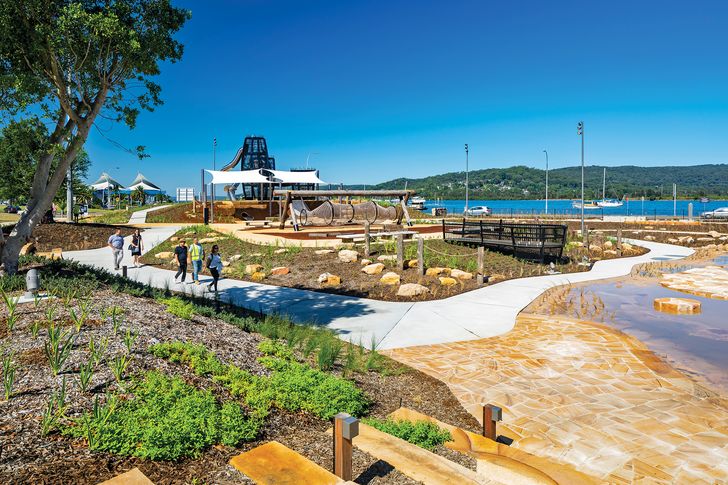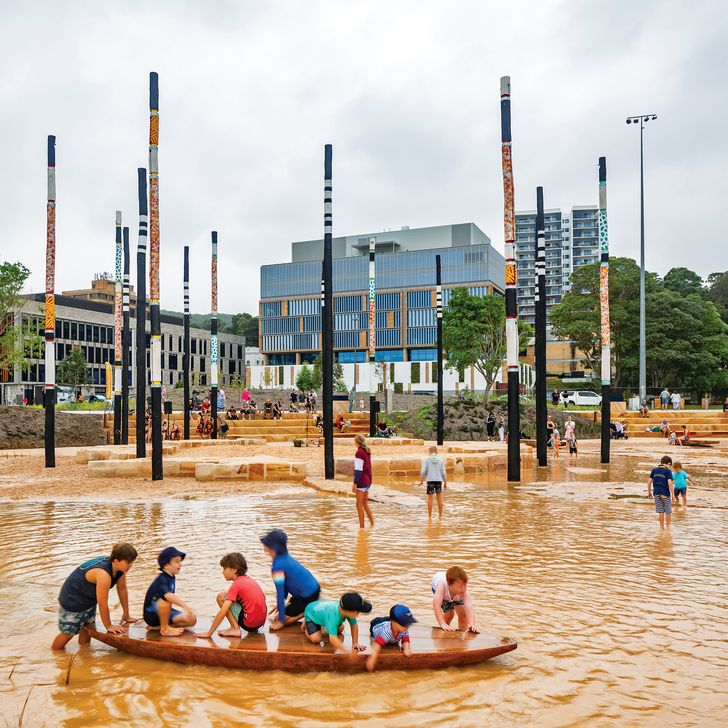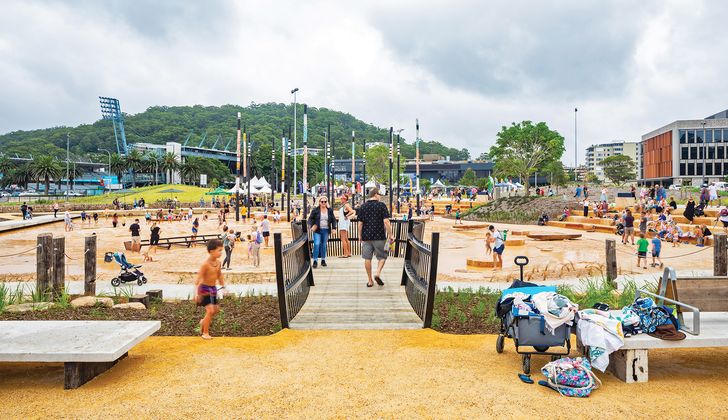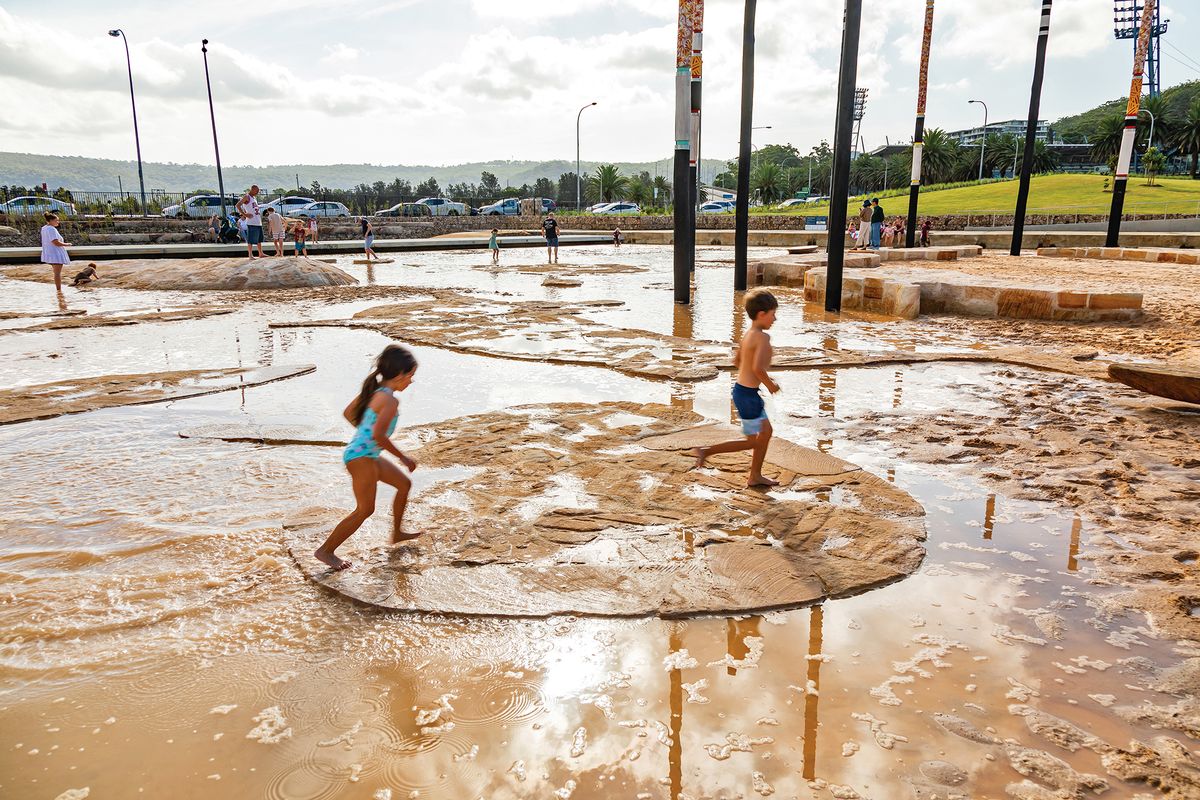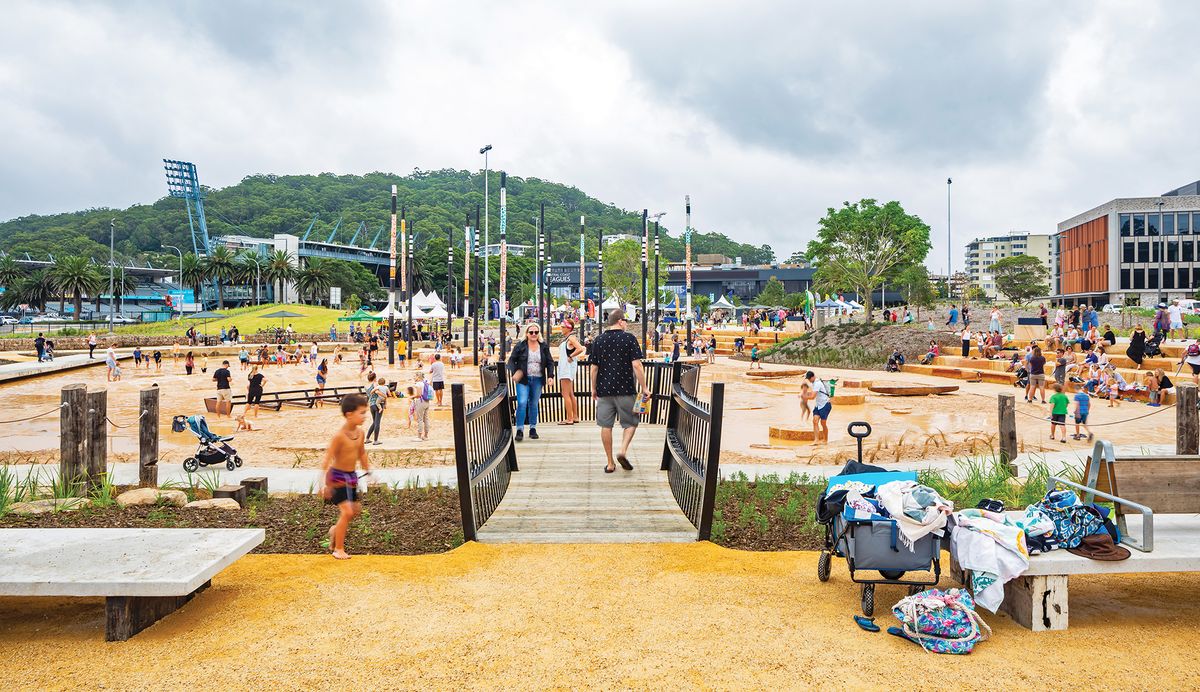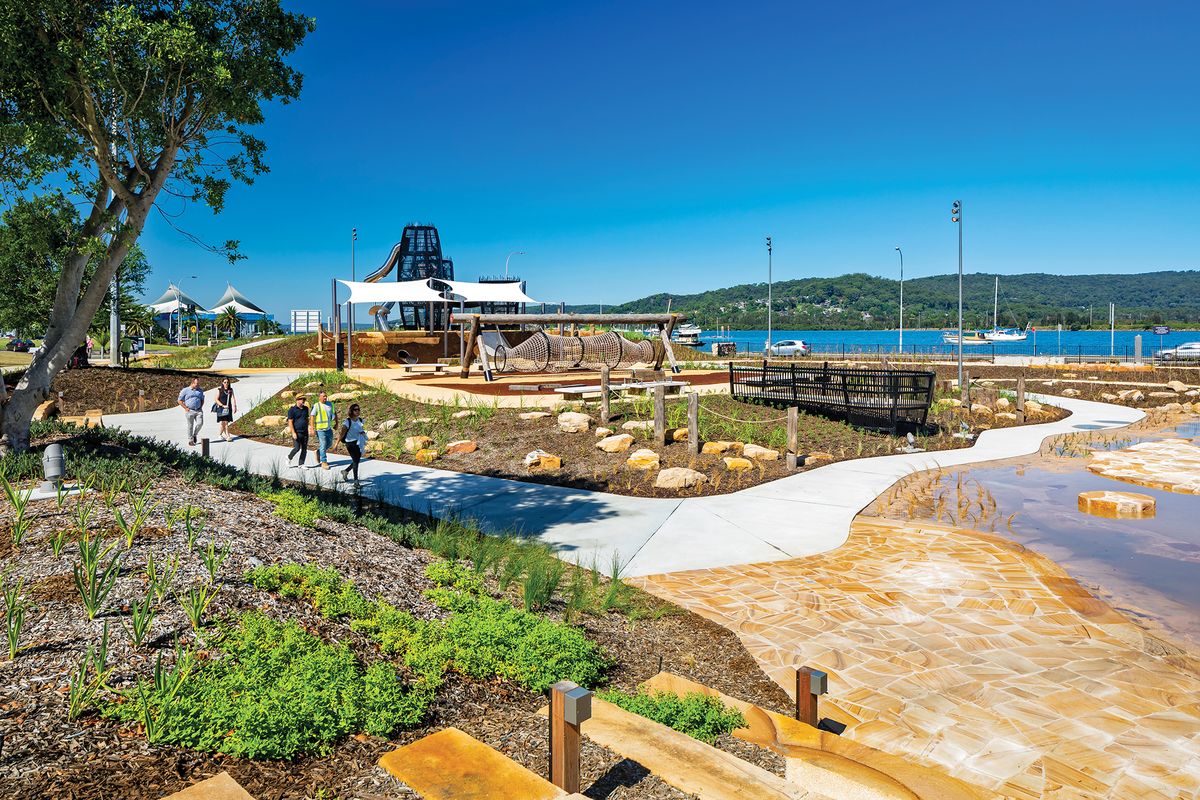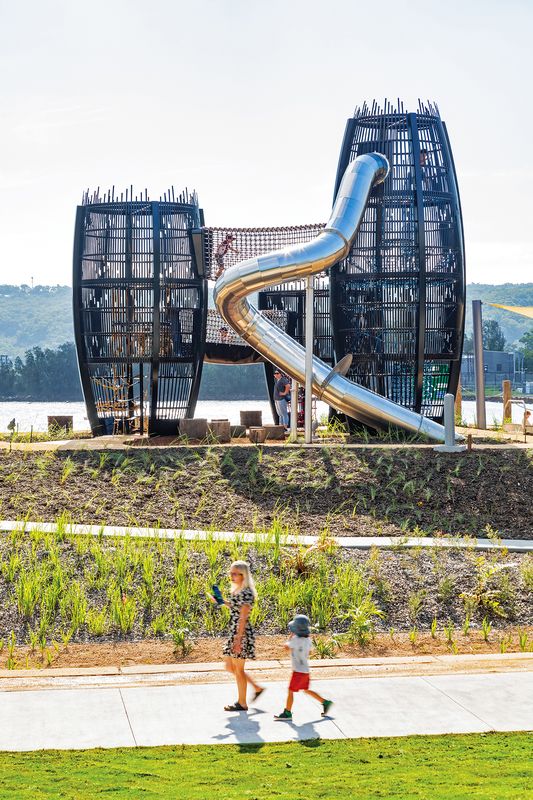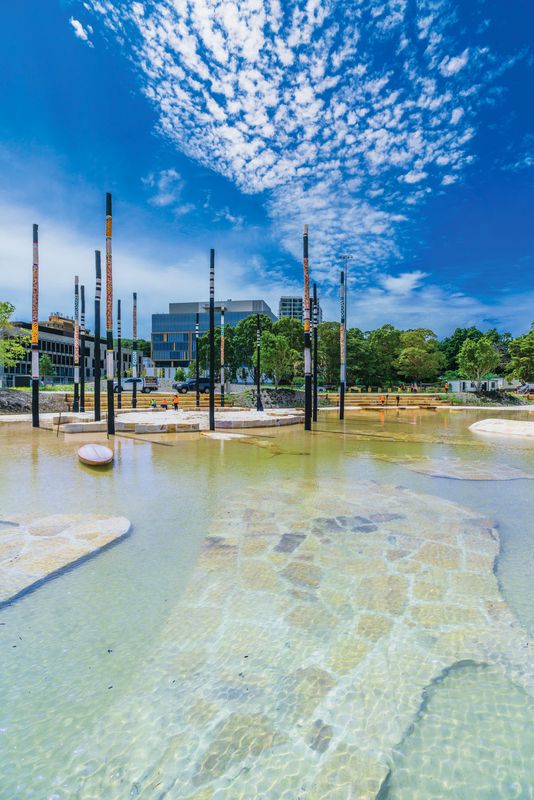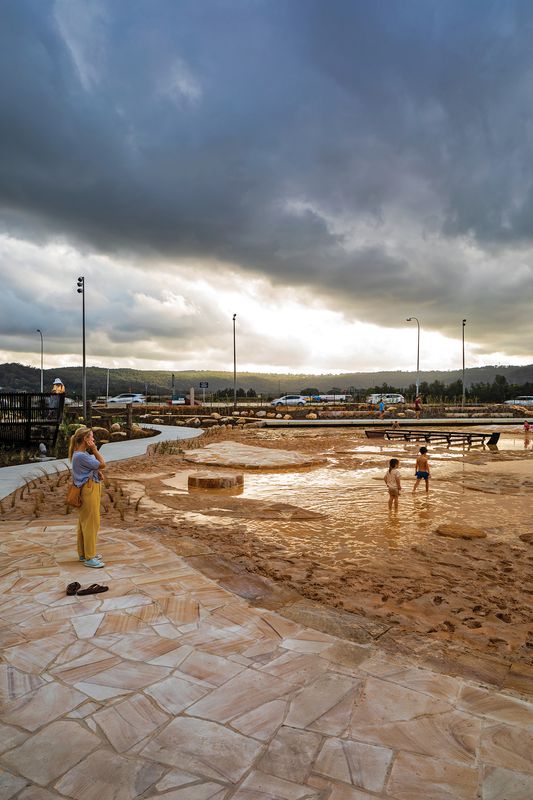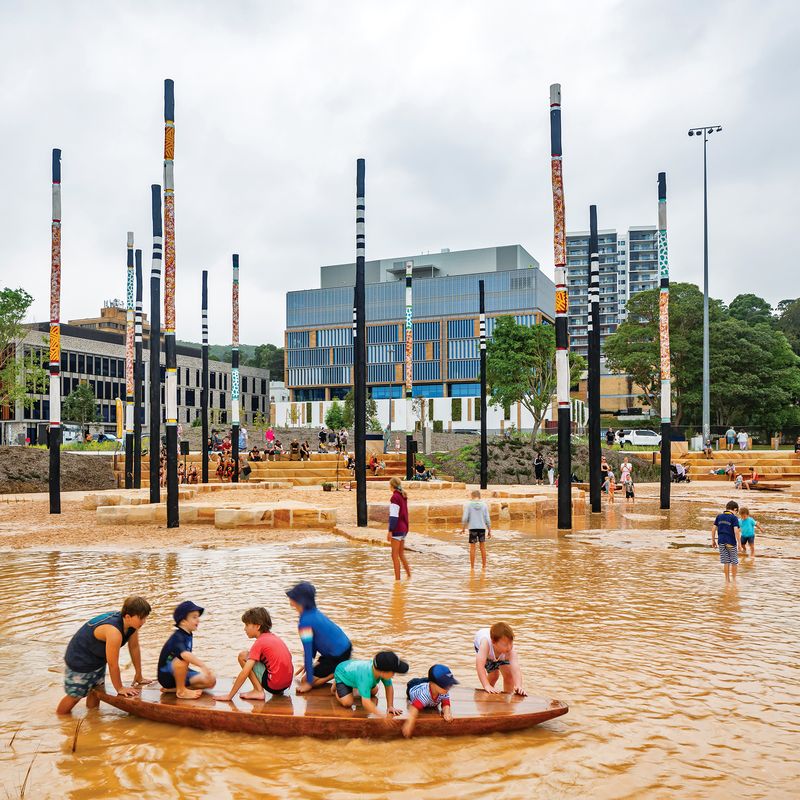Mike Horne, director at Turf Design Studio, spoke with Landscape Architecture Australia about how the designers worked with the area’s Traditional Owners, water management consultants, engineers and artists to create a park, gathering place and community hub that honours the site’s cultural histories and foregrounds the shifting, dynamic landscapes of its coastal location.
Michael Polifrone: What was the brief and how did Turf Design Studio’s engagement with the site’s Traditional Owners come about?
Mike Horne: When we started the project there were four fundamental requirements – a street connection, a community node, a playground and a village green – and so we thought, what do you do with that? What is a community node? It was such fertile ground for exploration and negotiation.
Indigenous engagement wasn’t specifically part of the brief, but it’s something we believe in. The Darkinjung Aboriginal Land Council had a land claim over the site and surrounding areas. We also knew they are a strong and active political group, so it was essential they be part of the process.
Image: Guy Wilkinson
MP: How was this collaborative relationship with the Land Council fostered?
MH: I rang them and asked Darkinjung along to a meeting about the site and at the start they were a little wary. At the first workshop they listened and for the next workshop they brought Uncle Gavi [Kevin “Gavi” Duncan, senior education and tourism officer at Darkinjung Aboriginal Land Council]. After a few more meetings, he offered to take us to the ridge tops around Gosford and we visited the rock engravings that the Darkinjung Aboriginal Land Council manages.
Processes of engagement with Traditional Owners can be complex, filtered and at times can become over-complicated. We wanted to connect directly with the Traditional Owners and to make it as inclusive as possible and get a conversation going where everyone has an equal opportunity to be heard.
MP: The project combines function and more poetic ideas in an inward-facing design. What was the design strategy?
MH: Our spatial strategy involved building mounds to bring the surrounding hills down into the park to express the landscape of Gosford in a microcosm and achieve the environmental objectives of not removing fill. The sandstone terraces are about creating new points of viewing: looking in, looking out, looking up.
The edges of the space are so important. An edge needs to be inhabited, it’s where you get people watching. It sets a stage where people can act and then those roles start to become interchangeable. The more social the space becomes, the more people begin to love it. Watching other people creates energy. I’m not sure that as a profession we have fully grasped the power of that quite yet.
The site of the park is physically separated from Brisbane Waters by the Central Coast Highway; the design reconnects the park with the tidal processes of the bay.
Image: Guy Wilkinson
MP: The tidal terrace is a fascinating gesture of the reconnection of Gosford to its ecologies, histories and Indigenous culture. How did the idea develop?
MH: We realized early we wanted to somehow connect the new park with Brisbane Waters. Our analysis revealed the shoreline had once been much further inland. This was shown on a 1921 survey, being the earliest lands department survey for the area. Shorelines are dynamic and never stay the same, but the survey gave us a reference point. Rather than just mark the path, we wanted to find the sea floor. We wanted to connect to Brisbane Waters, but there’s a big road [the Central Coast Highway] in the way, and so we thought, well if we can’t bring the park to the waters, let’s bring the water to the park.
Uncle Gavi told us that the site had once been a campsite for the Darkinjung people. There are journal entries from 1788 that say that when Governor Arthur Phillips’s survey parties were mapping the Brisbane waters and came up to Gosford, they found a marina of canoes here and a populated campsite. We wanted to tell the story of that moment in time.
I don’t think anyone has made a tidal terrace or tidal pool in a park before. We got a lot of bemused looks from the client, given the challenges of excavation on a landfill site and the barrier of the highway.
The Norimbah tidal terrace, central community node and dance ground forms the heart of the park and is defined by timber totems of the Darkinjung people and adjoining nations.
Image: Guy Wilkinson
The terrace fills with tidal sea water twice a day, creating an estuarine wild play area.
Image: Guy Wilkinson
MP: How is the terrace experienced and what was your approach to incorporating these dimensions into the overall park design?
MH: The tidal terrace is about getting back to the natural ground by reinterpreting the historic shoreline. It’s about restoring the connection that once existed between the site of the Gosford CBD and the water’s edge. The terrace fills with tidal sea water every high tide, creating a dynamic wild play area to explore, enjoy and learn from. The design of the terrace is enriched with layers of Indigenous culture and tells stories of local aquatic life, pre-European history and early contact. The invert level of the pipe connecting the tidal terrace to Brisbane Waters is set to mid-tide, ensuring the optimum level of water flow into the park and the inlet to the tidal terrace – the tidal gate – can isolate the terrace from Brisbane Waters when the water depth reaches 270 mm. The gate can be controlled remotely. This is, in part, to control the amount of water which enters the site in order to stay below 300 mm and reduce risks to park users.
MP: I’m interested in how you developed the terrace – did you use water flow simulation software or more analogue mapping methods?
MH: Civille was responsible for developing an analytical response to the tidal terrace as a functional design element which involved understanding the tidal conditions of Brisbane Waters, including how the rise and fall of the tide will fill and empty across the seasons of the year. Their investigations into water quality made the terrace a viable design concept, assuring stakeholders on a technical level that the design would be safe for users. The terrace fills and empties twice a day, with the tidal fluctuations bringing in a “new” volume of water, allowing safe water for play. The tidal gate, the overall mechanism that makes this design possible, was also developed and investigated through Civille’s work.
MP: The design functions as a tapestry of the social, the ecological and the cultural woven together through the medium of play. How did you approach balancing these different aspects?
MH – We needed to create a playground and a community node, so we thought let’s fuse that together and make a playground tell the story through play and experience. Life’s never in balance, instead, you’re always trying to seek balance. There’s never a frozen moment in the project because the tide keeps coming in and over the landscape. So, part of the story is about change, and the constant changes that are in every aspect of human experience.
In addition to the tidal terrace, the park encompasses a variety of additional play areas, an open lawn for civic events, a shared pedestrian zone and a fitness precinct.
Image: Guy Wilkinson
MP: Did you investigate the ecology of the area as part of the design development process?
MH: Troy Gaston, a senior lecturer in environmental science at University of Newcastle, and David Wainwright, a coastal water resources and environmental engineer at Salients, were on the team to provide a Review of Environmental Factors as a part of the park’s planning requirements. This included research, analysis and documentation of the effects of the pipe between the park and Brisbane Waters on marine species within and adjacent to the zone of influence. This analysis showed no significant ecological impacts. The tidal gate allows for some species to move through the pipe into the tidal terrace, including crabs, sea snails, and worms. Oysters are controlled by closing the tidal gate with annual hose down of stone elements. It’s a balance between enabling marine ecology and safety for a play environment.
MP: Upon visiting the site, it’s obvious that it’s being well-used by the community. How do you judge the project at this stage?
MH – It’s still early days, it’s only just opened. Landscapes evolve, that’s one of the great conundrums of designing landscapes, so landscape projects are often best looked at seven or eight years on.
Credits
- Project
- Gosford Leagues Club Park
- Design practice
- Turf Design
Sydney, NSW, Australia
- Project Team
- Mike Horne, Scott Jackson, Abdullah Richards, Danica Bird, Brigitta Schyns
- Consultants
-
Access, BCA and PCA
CCEP Consulting Coordination
Arborist Australis Tree Management
Artist Kevin “Uncle Gavi” Duncan
Civil engineer ADW Johnson
Contractor Landscape Solutions
Design leader Turf Design
Geotechnical engineer SESL Australia, Douglas Partners
Heritage consultant GML Heritage
Landscape architect Turf Design
Lighting design Electrolight
Placemaking RobertsDay
Project manager TSA Management
Public art Studio TCS (Turpin and Crawford Studio)
Public domain design Turf Design
Quantity surveyor WT Partnership
Signage and graphics Wordplay Studio
Soil engineering SESL Australia
Stakeholder Central Coast Council Darkinjung Aboriginal Land Council
Team project manager Level Six Venture Management
Traffic consultant The Transport Planning Partnership (TTPP)
Urban planning Barr Property and Planning
Water feature and irrigation design SDC Engineering
- Aboriginal Nation
- Built on the land of the Darkinjung people
- Site Details
-
Site type
Coastal
- Project Details
-
Status
Built
Design, documentation 10 months
Construction 23 months
Category Landscape / urban
Type Parks, Playgrounds, Public / civic
- Client
-
Client name
Hunter and Central Coast Development Corporation
Source
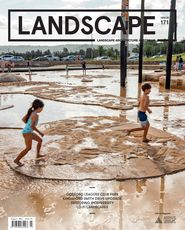
Review
Published online: 26 Aug 2021
Words:
Michael Polifrone
Images:
Guy Wilkinson
Issue
Landscape Architecture Australia, August 2021

